Complete Guide to
Truck Route Planning:
Understanding the importance and benefits of Routing Solutions
Truck route planning plays a crucial role in the logistics industry, transforming manual processes into efficient, optimized routes that save time and reduce costs. In this e-book, we will explore key aspects of truck route planning and how businesses can benefit from adopting advanced route optimization solutions.

What is Truck Route Planning?
Truck route planning is the process of generating the most ideal and efficient routes for trucks. These routes are created when a truck needs to move from location A to location B or vice versa.
Route planning considers multiple factors, such as the location of the idle truck, the distance required to reach the required destination, traffic conditions, road restrictions (if any), vehicle size considerations, capacity management of the vehicle, availability of drivers, and many more. All these constraints are accommodated while generating a route plan for a particular truck.
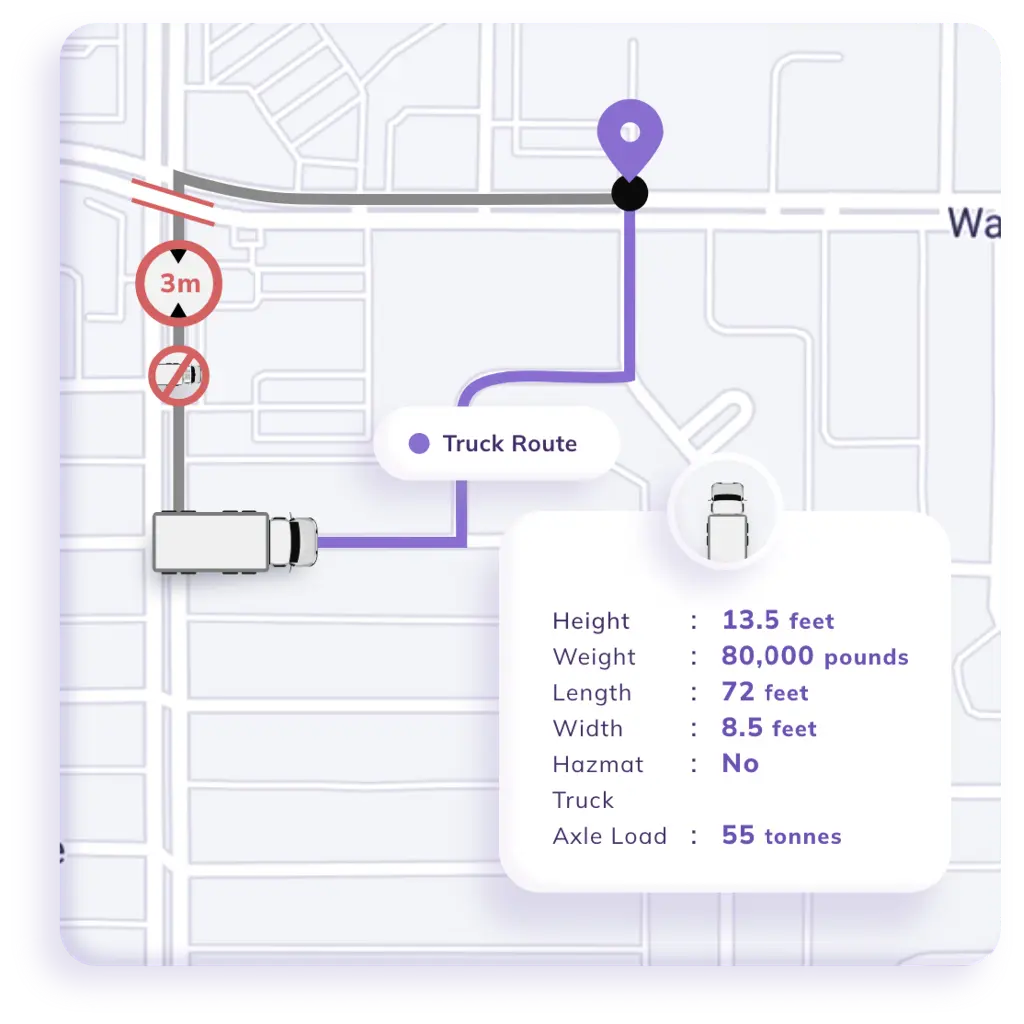
Truck route planning is a process that takes into account all the factors mentioned earlier, as well as the specific needs of the business and its customers. The primary goal of this process is to provide efficient routes, optimize resource allocation, and maximize productivity, all while managing the increasing operational costs of the business.
Traditionally, the logistical sectors relied on manual route planning. However, with the increasing role of technology in the transportation industry, businesses are now transitioning to automated route-planning solutions. This shift not only saves time in creating the plan but also reduces the likelihood of human error in route generation.
Importance of optimized truck routing
in logistics and supply chain
Optimized truck routing has been a noteworthy advancement in the logistics and supply chain industry. From adjusting and streamlining route plans to complement trucks movement to providing end-to-end navigation to the trucks, an optimized route can be a game changer move for the trucking industry.
Here’s a classical scenario showcasing the importance of optimized truck routing vs unoptimized truck routing.
ABC trucking company has a fleet of 10 trucks and operates in a 5 km area. The company does not use any route planning software or processes to streamline its truck routes. The company struggles to scale its operations as, with its limited fleet count, it was able to complete a fixed number of tasks only. Moreover, the company was not able to accommodate any ad-hoc tasks or was limited to scaling its operations without adding any new trucks.
Contrastingly, XYZ, a truck company with a similar fleet count and operating in the same 5 km area, made a strategic decision to adopt route optimization software. This decision proved to be a game-changer. In a remarkably short time, the company was able to increase its task volume while maintaining resource efficiency significantly.
In both cases, the output in terms of performance and revenue differs because of one decision: adding the right technology at the right time.
Complete Guide to
Truck Route Planning
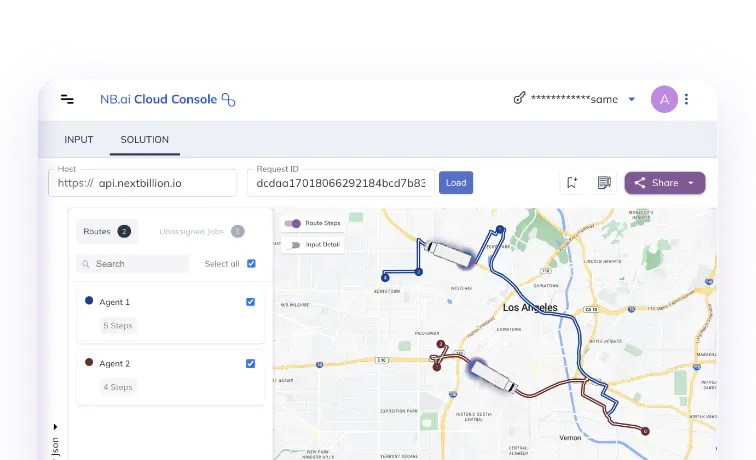
Challenges Associated with
Traditional Route Planning Methods
Getting acquainted with route planning to support and scale your trucking operations is an ideal choice. However, there are a few instances where businesses opt for traditional route planning methods to support their logistical operations.
There are multiple challenges and dependencies associated with traditional route planning methods which in return can significantly impact the overall success and impact of trucking operations.
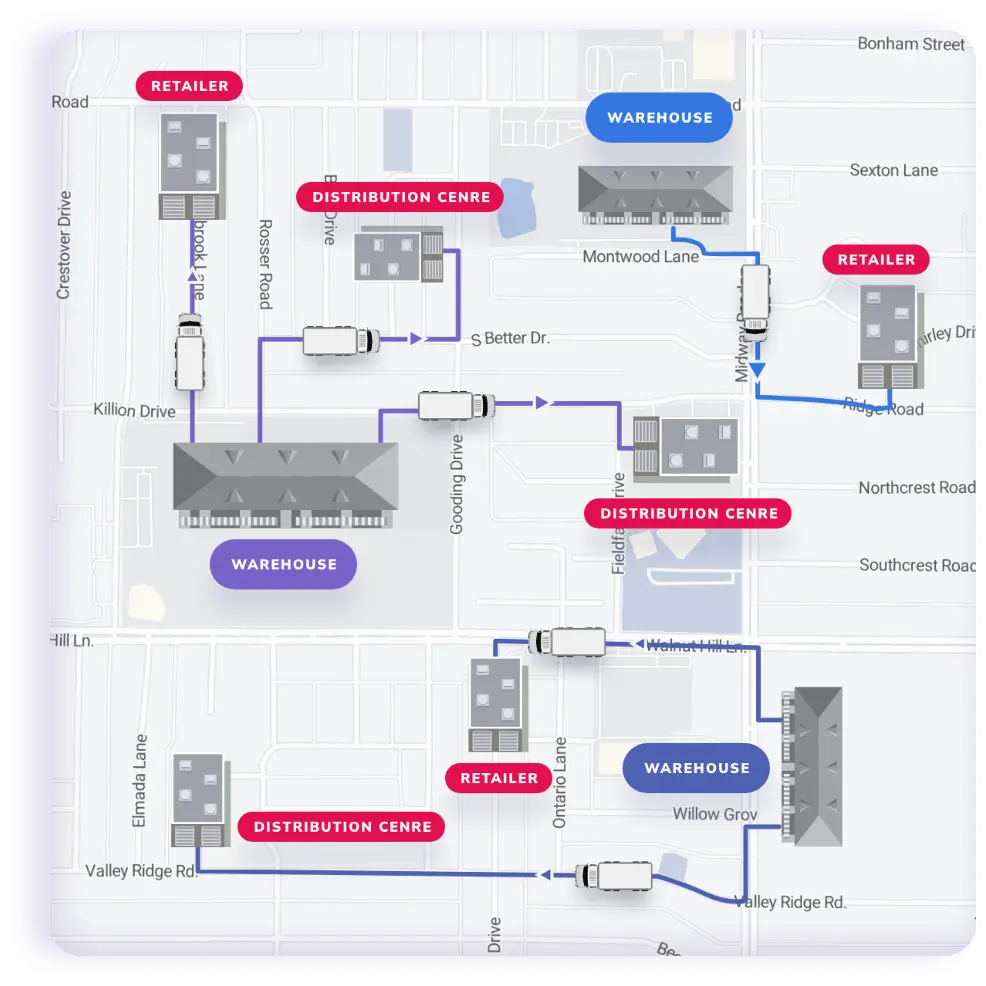
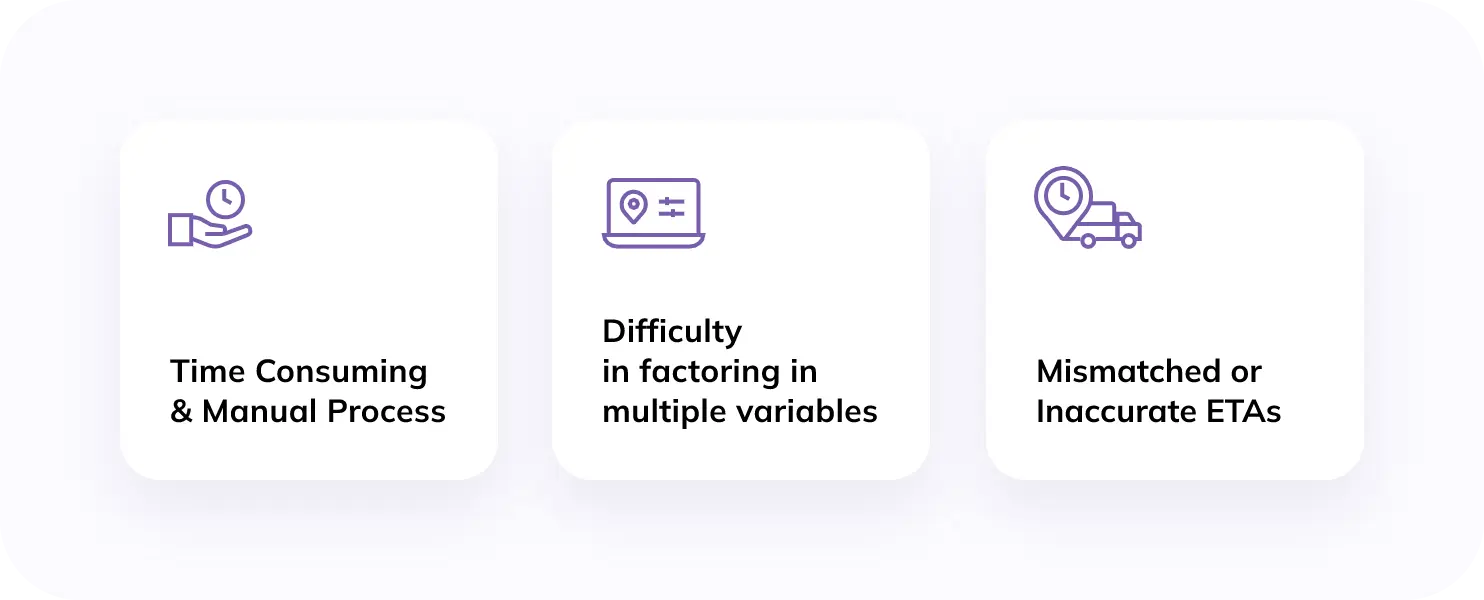
Time Consuming & Manual Process
Most of the businesses rely on traditional ways to plan truck routes. One major setback with this approach is that it is very time consuming. The manual process makes it prone to errors and can lead to operational inefficiencies.
Slower decision making, limited considerations to dynamic factors, and limited scalability are a few of challenges associated with traditional ways to plan routes. Moreover, lack of automation in allocating drivers, load distribution and adjusting ad-hoc requests can lead to significant delays in complying with shared ETAs.
Difficulty in factoring in multiple variables ( traffic, weather, regulations)
Factoring in multiple variables like traffic, weather, and logistics regulations can be extremely challenging without automated solutions. These dynamic variables require constant monitoring and adjustments at any point of operations. Businesses relying on traditional systems cannot integrate real-time data, leading to inefficient routes, delays, or non-compliance with regulations.
Mismatched or Inaccurate ETAs
Traditional route planning methods lack the ability to adjust for real-time dynamic factors such as traffic, weather, and last-minute requests. This inability leads to inaccurate or mismatched ETAs, as these systems don’t account for rapidly changing conditions. Without incorporating these crucial elements, ETA predictions often fall short, causing delays and inefficiencies. This gap can significantly impact the SLA adhere and operational productivity.
Benefits of Optimized Truck Routing
Optimized truck routing ensures SLA adherence, reduces delays and helps in fostering trust among customers and many more. Businesses of any scale are opting for optimized truck routings to ensure their operational efficiency rises as their business scales.
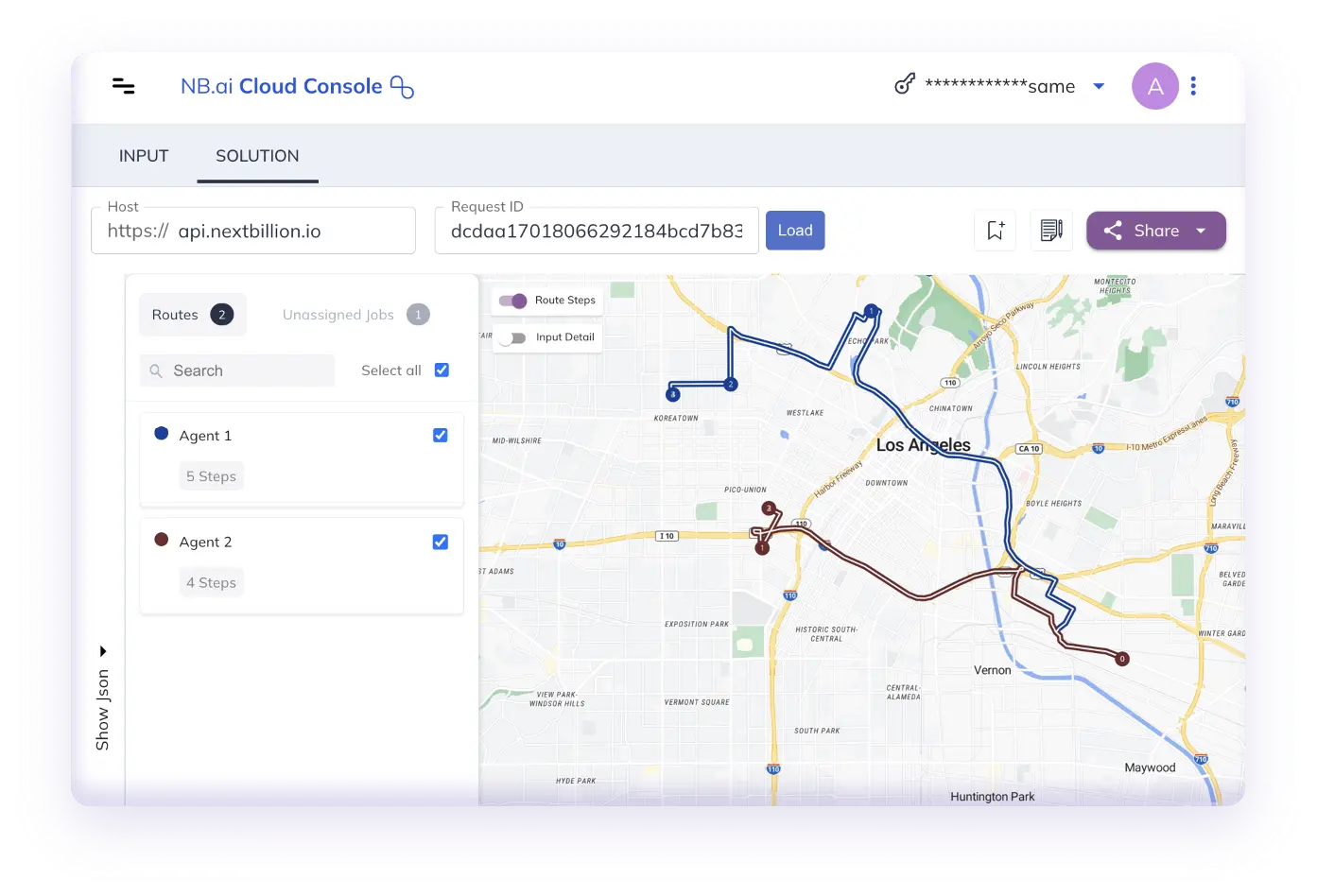
Here are a few of the classical benefits of optimized routes.
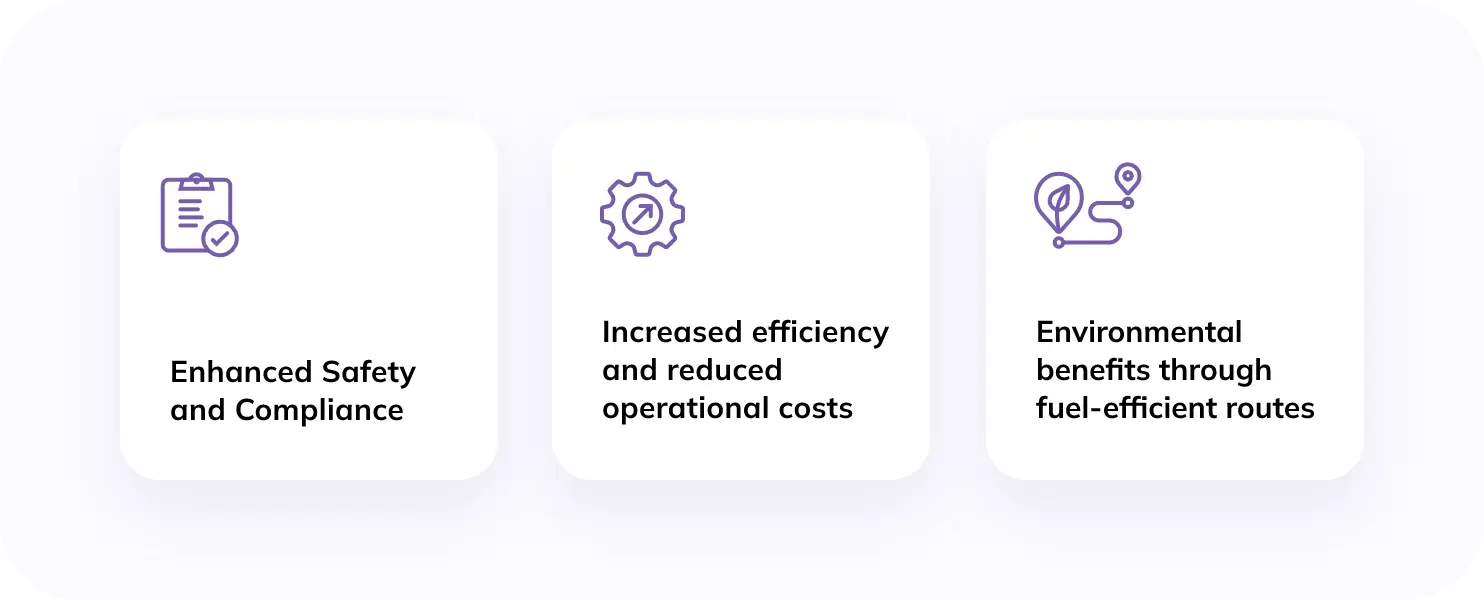
Enhanced Safety and Compliance
With optimized truck routes, businesses can have custom-prepared route plans that complement and accommodate safety requirements by avoiding roads with known hazards. It not only reduces the risk of accidents but also enhances the safety of both drivers and trucks. Multiple factors, such as accident-prone areas, road conditions, and real-time traffic data are taken into consideration to navigate safer pathways.
Moreover, the generated routes are designed to consider regulatory requirements and compliance standards specific to trucks, such as weight limits, bridge restrictions, and hazardous materials regulations. By following these tailored routes, trucking companies can avoid fines, stay within legal boundaries, and improve operational efficiency, all while prioritizing safety.
Increased efficiency and reduced operational costs
The routing algorithm allows businesses to leverage the best-suited route for completing the job.When generating a route plan, factors such as assigning the job to the most suitable and nearest available driver, along with creating a shorter, safer route, are carefully considered. This approach not only ensures optimal resource allocation but also enhances operational efficiency.
By optimizing the routes, companies can make better use of their workforce and vehicles, leading to reduced fuel consumption and minimized travel time. These factors contribute to lower operational costs, as resources are used more efficiently, and costly delays or accidents are avoided. The algorithm's ability to streamline tasks and optimize every aspect of the route planning process ultimately enhances overall productivity while keeping costs in check.
Environmental benefits through fuel-efficient routes
An added significant benefit of choosing optimized truck routing is that these fuel-efficient routes Fuel-efficient routes provide significant environmental benefits by reducing fuel consumption and minimizing the carbon footprint of transportation operations. By using optimized routes, trucks can take shorter, less congested paths, which leads to less idling and more consistent speeds. This not only lowers fuel usage but also reduces greenhouse gas emissions and other pollutants.
Additionally, fuel-efficient routes contribute to fewer vehicle wear and tear, extending the lifespan of trucks and reducing the need for frequent maintenance and replacement parts, which also benefits the environment. By integrating eco-friendly practices such as these, companies can not only reduce their operational costs but also promote sustainability and contribute to cleaner air and reduced emissions, aligning with global environmental goals.
Use Cases and Real-World Scenarios
Truck route planning is a widely accepted and appreciated process within truck vertical business. There are multiple instances where the presence of truck routing has significantly helped businesses to accomplish their growth goals, amplify their resources productivity and enhance the overall operational efficiency. Below are enlisted situations requiring specialized truck routing.
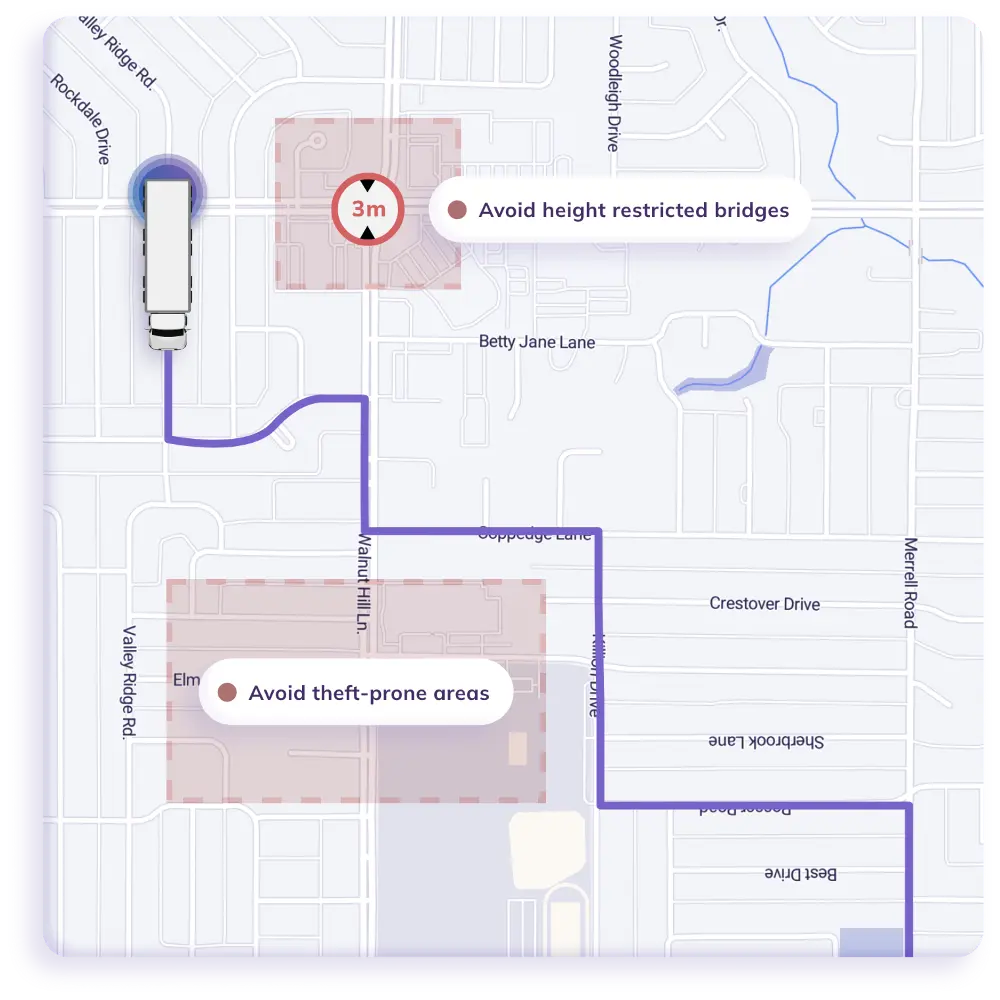
Critical situations requiring specialized truck routing
Oversized or Overweight Loads:
Instances where the trucks are commuting with oversized or overweight loads, an optimized truck routing can be used. The generated routes can help in skipping low bridges, weight-restricted roads, or sharp turns.
Construction Zones and Road Maintenance:
An ahead truck routing can help in avoiding roads with temporary closure because of ongoing maintenance or construction. This enables truck drivers to avoid narrow lanes and routes with potential hazards.
Transporting Hazardous Materials:
In cases where moving trucks carry chemicals, fuels or other hazardous materials, trucks should adhere to allocated specific routes to avoid populated areas. The truck routing process ensures generating a route plan that complies with the regulations specific to movement of dangerous goods.
High Security Transport:
To minimize risk of theft, truck routing enables geocoding via which a complete monitoring of the real-time movement of the vehicle can be done. In case of any deviation from the assigned route, a quick notification can be shared across to all the relevant stakeholders.
And many more! A specialized truck routing is indeed an integral part of the operational process that helps in adhering to route compliance, enhancing the safety and efficiency of the logistical processes.
Case studies showcasing successful implementations

Truck Solutions Provider Boosts Growth & Cut Costs by 30%
A US-based startup offering AI-driven trucking logistics significantly faced challenges with their growing costs and inability to scale while keeping a check over the existing resources. To address their scalability issues and monitor the cost, they opted for truck specific routing solutions.
This has enabled them to procure routes which can be generated in real-time to accommodate the dynamic & ad-hoc requirements. The quick decision making, faster response times and customized routing contributed to improve scalability of their existing operations and reduce cost by 30%.
To know, in depth about how and why of this case study, click here.

Waste Management Company Streamlined their Routing Operations
A mexico-based waste collection company was facing critical operational challenges due to lack of specific truck routing in their existing navigation system. Unsuitable routing, rising operational costs and sub-optimal planning were constantly responsible for reducing the operational efficiency of the business.
The company collaborated for a truck routing solution where custom-fit routes were generated to complement movement of trucks in those specific locations based on regulations, road conditions as well as optimal pairing of drivers, vehicle and job locations were done.
This has enabled the business to experience the enhanced resource productivity, SLA adherence and productive operations.
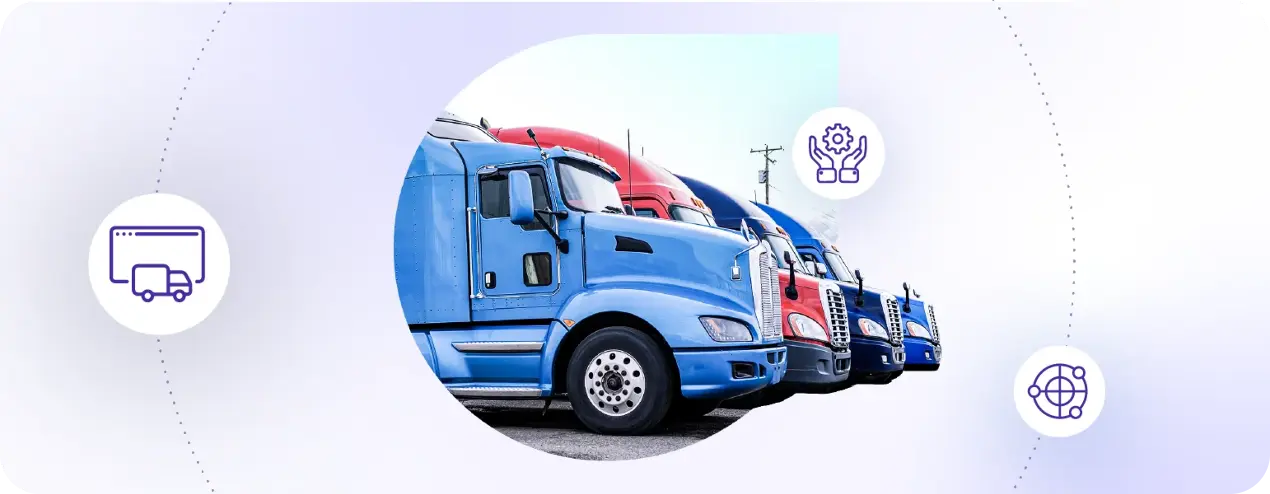
A B2B Trucking Logistics Startup Improves Cost Estimation
An Indian B2B Logistics startup was looking for practical solutions to get efficient costs, better performance in their mobile application and higher accuracy for addresses. The company wanted to address the pain points of generating optimized routes and accurate cost estimates upfront for the customer.
They paired up with a truck routing solution to easily calculate exact prices for transportation costs. With optimized truck routing, they were able to streamline vehicle dispatch and response times, identify and navigate to warehouses and repair stops, and track delivery trucks in real time.
Fundamentals of Truck Route Planning
Efficient route planning is essential for trucking businesses. Commercial vehicles need optimized truck routes to support their revenue growth and operational success. Before getting started with the process of generating optimized routes, a business must know the fundamentals and the associated impact of truck route planning as a whole.
Understanding Truck Routing Factors
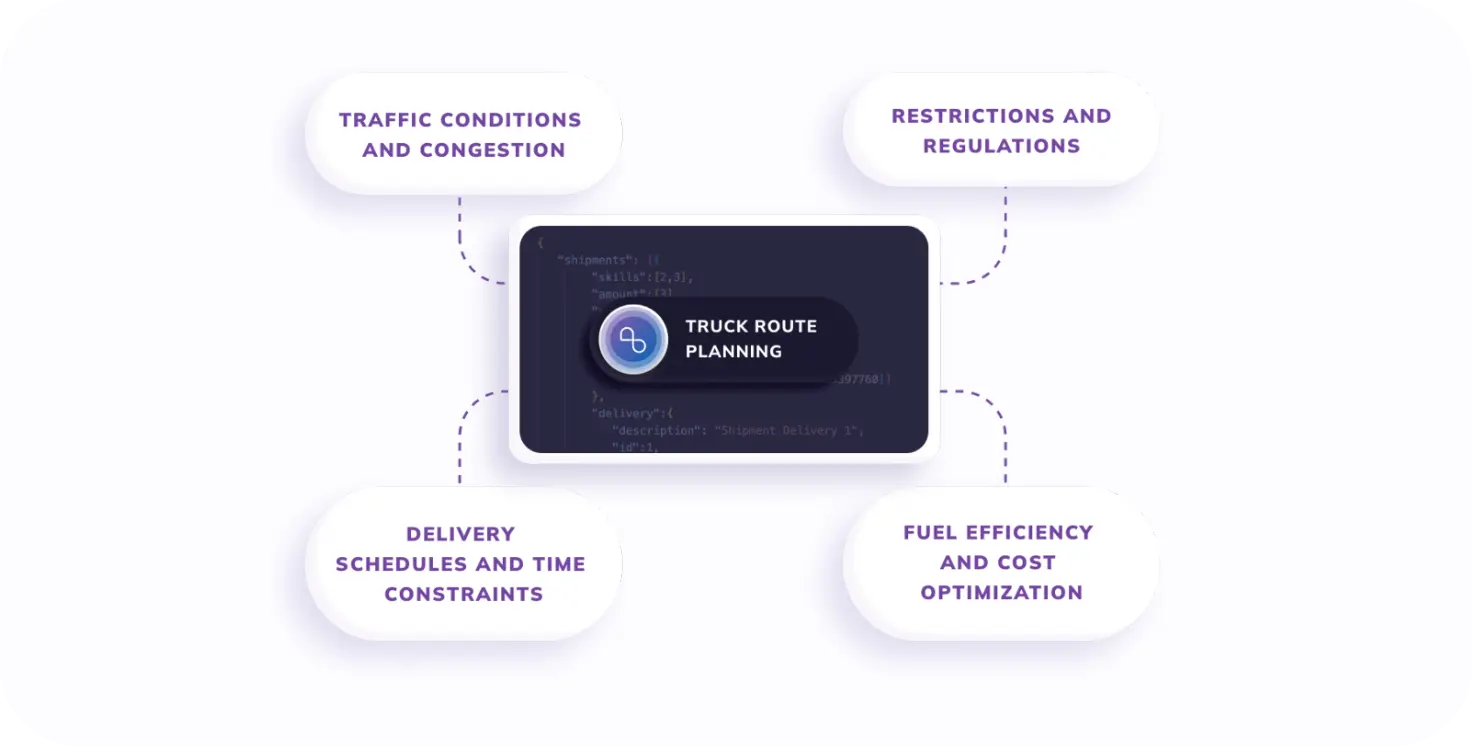
Restrictions & Regulations
When planning truck routes, it is crucial to consider various road restrictions and regulations, including speed limits, that may impact the movement of trucks. These restrictions are typically imposed to ensure the safety of both the truck drivers and other road users. Some key factors to consider are:
Weight Restrictions: Different roads and bridges have specific weight limits to prevent structural damage. Trucks must adhere to these limits to avoid overloading, which could lead to accidents or infrastructure deterioration. Truck routing software considers weight restrictions to determine suitable routes that comply with these limitations.
Height Restrictions: Certain roads, tunnels, or overpasses have height restrictions due to low clearance. Trucks with tall cargo or oversized vehicles need to carefully select routes that accommodate their height requirements. Neglecting height restrictions can result in accidents, damage to the truck, or obstructions to other traffic.
Width Restrictions: Similar to height restrictions, some roads or bridges have limitations on vehicle width. Wide loads, such as oversized cargo or trucks with extended mirrors, need to take into account these restrictions to avoid collisions or damage to infrastructure. Route planners factor in width restrictions to choose appropriate paths for such vehicles.
Hazardous Material Restrictions: Hazardous materials, such as flammable or toxic substances, have specific regulations regarding their transportation. Certain roads or areas may prohibit or limit the transport of these materials to minimize potential risks. Route planners consider hazardous material restrictions to ensure compliance and identify suitable routes that accommodate the safe transport of such cargo.
Traffic conditions and Congestion
Efficient truck route planning must take into account the prevailing traffic conditions and potential congestion along the proposed routes. The following factors influence traffic conditions:
Peak Hours and Traffic Patterns: Truck routing software considers peak traffic hours and patterns, identifying times when road congestion is likely to be higher. By avoiding peak hours or strategically planning routes to minimize exposure to heavy traffic, truck drivers can save time and reduce delays.
Road Construction and Closures: Construction activities or road closures can significantly impact truck routes. Truck route planners analyze real-time data and stay updated on ongoing road construction projects or closures to determine alternative routes that bypass these areas. By avoiding construction zones, truck drivers can avoid unnecessary delays and disruptions.
While Google Maps can provide general directions for trucks, it lacks the necessary features to account for trucking-specific requirements such as vehicle size and road restrictions. It is more suited for consumer route planning and can be used in conjunction with specialized truck route planners for better efficiency.
Delivery Schedules and Time Constraints
Truck route planning must align with delivery schedules and time constraints imposed by customers or contractual obligations. The following considerations come into play:
Delivery Priorities: Delivery schedules and priorities may vary depending on the nature of the cargo and customer requirements. Some deliveries may have strict time windows or urgent deadlines. Truck route planners prioritize these deliveries to ensure timely arrival.
Time of Service: Some locations may have restrictions on the times when trucks can access or make deliveries. These time constraints must be considered during route planning to avoid conflicts or violations.
Fuel Efficiency and Cost Optimization
Truck route planning also aims to optimize fuel efficiency and minimize costs. The following factors influence fuel consumption and cost optimization:
1. Distance: Selecting the shortest possible route helps reduce fuel consumption and overall transportation costs. Truck route planners calculate the distances between locations and consider alternative routes that minimize mileage.
2. Fuel Stations: The availability of fuel stations along the planned route is crucial for long-haul trucking. Route planners consider fuel station locations and plan routes that ensure convenient access to refueling points.
3. Traffic Flow: Smooth traffic flow without frequent stops or traffic congestion helps maintain consistent speed, reducing fuel consumption. Route planners evaluate real-time traffic data to select routes with minimal traffic disruptions.
Using truck GPS systems can further optimize fuel efficiency and reduce costs by providing accurate route planning and real-time traffic updates.
Truck route planning takes into account these factors to optimize efficiency, reduce costs, and ensure timely deliveries, ultimately improving overall operational performance.
Complete Guide to Truck Route Planning

Mastering the Truck Route Planning Process
There are multiple phases that sum up the route planning process for a trucking business. Here’s an overview of key stages of the process:
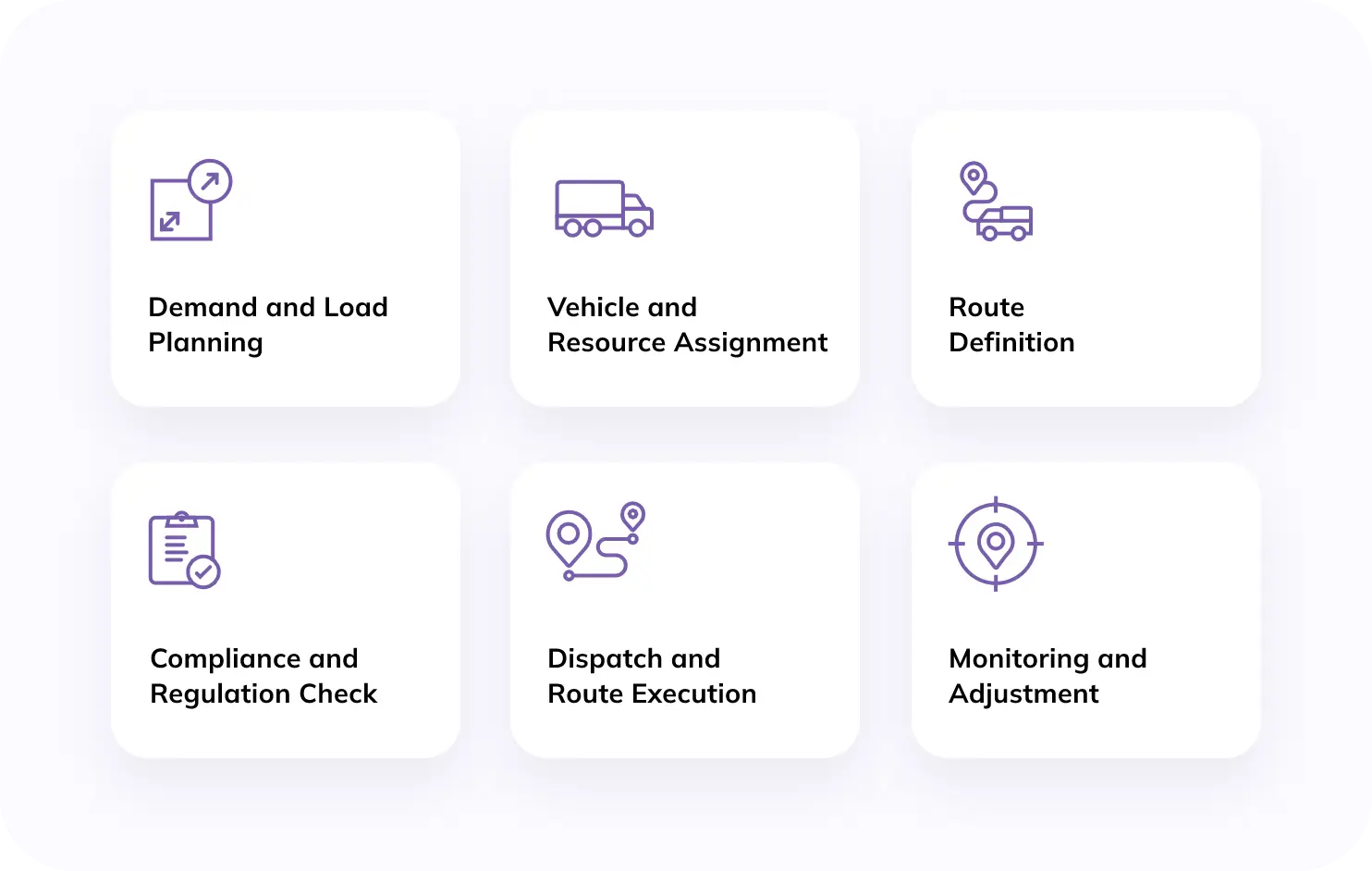
Demand and Load Planning
Order Collection
This step includes collecting and organizing the delivery or pickup orders from various assigned places. Before creating the plan, a complete detail of each load such as weight, size, delivery window are taken into consideration.
Load Prioritization
This step includes preparing a prioritization list of deliveries based on various deadlines, customer requirements, type of loaded items ( special attention in case of perishable food, fragile food).
Vehicle and Resource Assignment
Vehicle Selection
This step helps in pairing of the trucks based on the loads capacity, fuel efficiency.
Driver Assignment
Best suitable driver based on availability, route familiarity, and legal driving hours (hours-of-service regulations) is done to start the job.
Route Definition
Location Mapping
Stakeholders enter the delivery and pick up points ( along with multiple stops) in a map.
Route Optimization Algorithm
Considering real-time factors, along with the location inputs, the route optimization algorithm generates a route plan.
Constraint Management
Route planner can add any operational constraint such as weight limit, vehicle capacity limit, delivery time windows etc in the system to manage the constraints at the initial stage of planning.
Compliance and Regulation Check
Legal Compliance
Routes generated are evaluated automatically to ensure its compliance with local, state or federal regulations.
Dispatch and Route Execution
Dispatching Drivers
The route plan generated comprehensively is now shared with drivers along with information such as load details, instructions list to drivers ( if any).
Real-Time Tracking
With GPS tracking, the operations team can closely monitor the vehicle position, route adherence and can share real-time updates or any potential disruptions in the route.
Monitoring and Adjustment
Real-Time Adjustments
In adherence to the SLAs, generated routes might need to be adjusted to complement the unexpected events such as road closure, vehicle breakdown. The dynamic route adjustment allows businesses to accommodate the timely deliveries efficiently.
The above-mentioned processes are a 360 degree overview of what the process looks like. To get in depth information about the “ how” of the process, book your appointment with our route experts today!
Leveraging NextBillion.ai Truck Route Planning
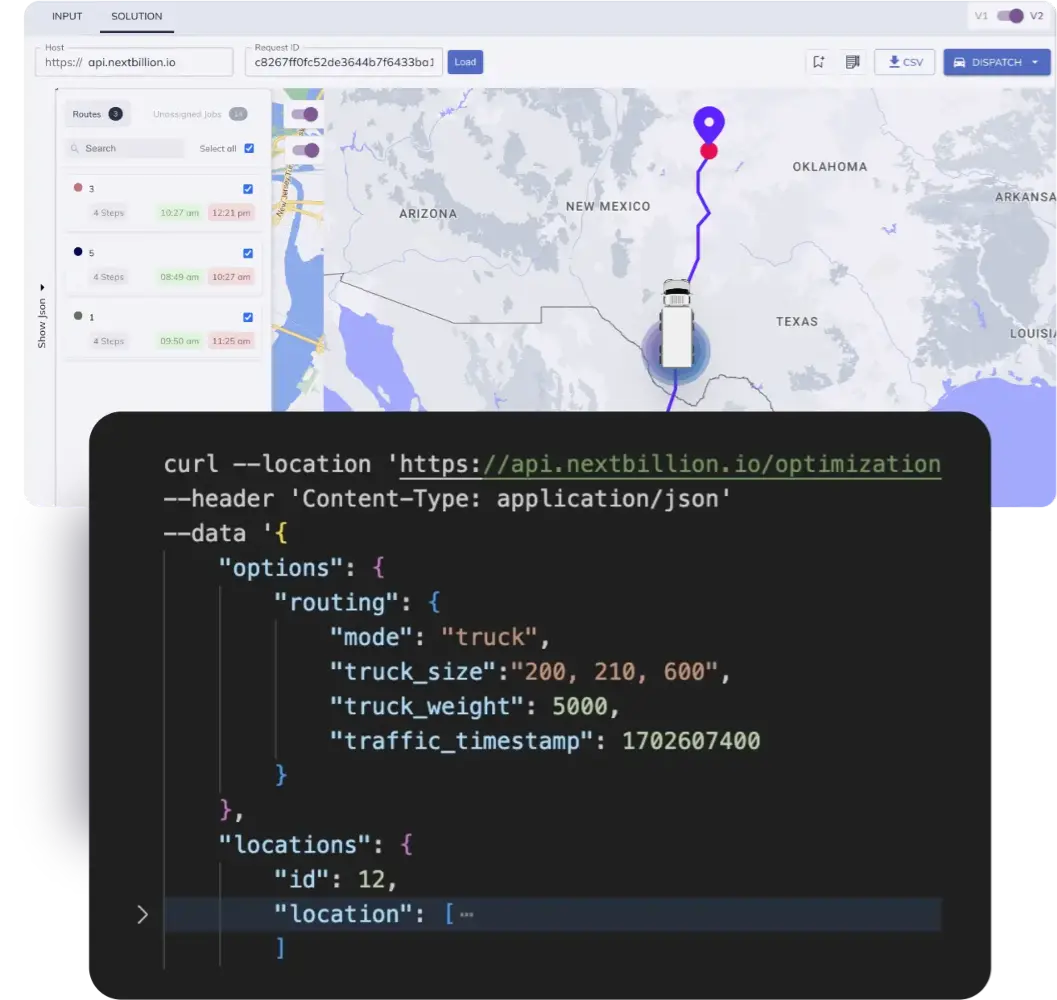
Key features of the Truck Routing API
From route optimization and compliance to real-time tracking and post-trip analysis, NextBillion.ai offers a comprehensive suite of tools. These tools are designed to enhance efficiency, ensure regulatory compliance, and reduce operational risks, making them indispensable for modern trucking operations.
Truck Complaint Routes
This feature allows businesses to generate routes based on truck size, weight and transportation of hazmat materials.
Optimize Route for Multiple Trucks
By leveraging over 50+ constraints, the APIs allow truck businesses to generate optimized truck routes and create schedules to accommodate routes for multiple trucks.
Avoid Sharp Turns and U-turns
Keeping into consideration the practical challenges associated with taking sharp and U-turns, the optimized truck routes tend to avoid these routes.
HOS compliant Truck Routes
Get optimized truck routes which are compliant with hours of services. Based on the fleet and driver, you can enter the constraints and get a specific route.
Truck Routes with Multiple Stops
NextBillion.ai supports your operations' scalability. With truck route API, you can get optimized routes while covering multiple waypoints.
Arrive on Curbside
Based on the specific requirements, you can get routes to arrive at your stop only on the curbside. This helps in ensuring SLA adherence, avoiding any operational interruptions and many more.
Trace Route Taken
The truck route API offers the end to end tracing of routes taken by your truck after the trip.This helps in keeping a close check on the vehicle’s real-time status.
Set Service Boundaries
This feature enables businesses to define the areas which can be serviced by your trucks within a given set of constraints.
Avoid Tolls on the Route
Get a truck route API that ensures that your fleet is not taking the roads with tolls. This helps in controlling the operational as well as add-on costs.
Truck Routes with Weight Limits
Businesses often face challenges to avoid routes which are not suitable for the given truck weight. This API sets restrictions to generate inefficient routes at any point of time.
Integration capabilities with existing systems
NextBillion.ai truck route APIs can be seamlessly integrated with different telematics, TMS, CRMs as well as ERP Systems. These integrations help in enhancing your field service efficiencies. These integrations enable businesses to:
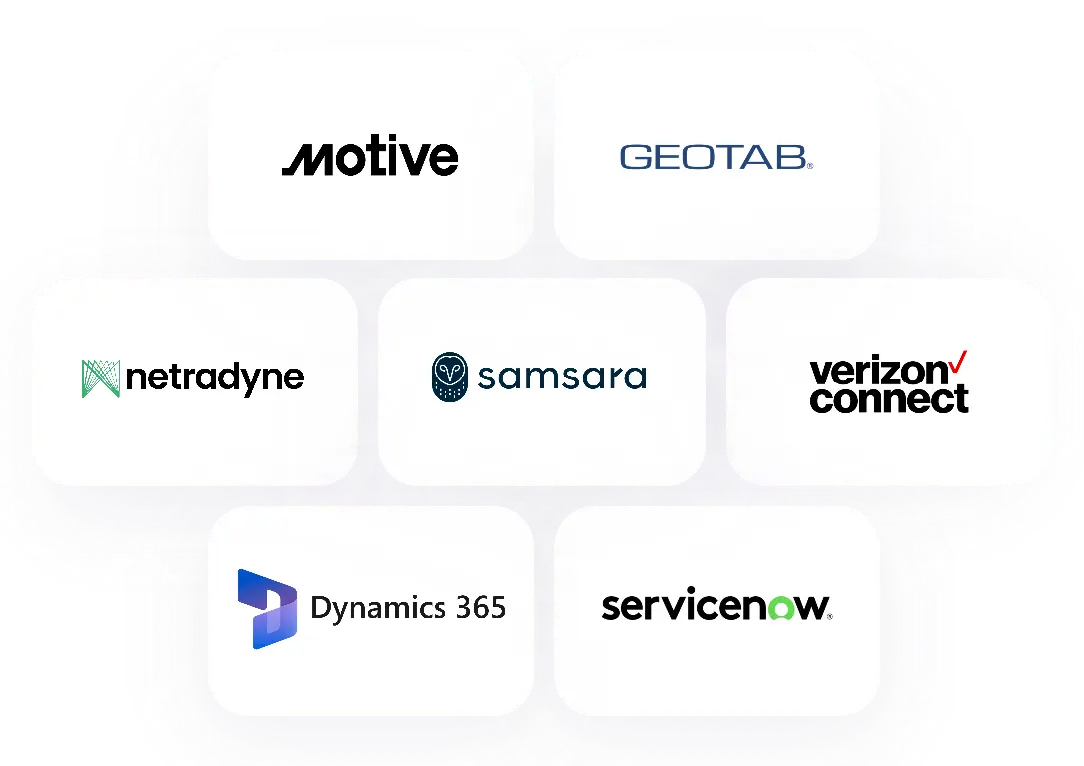
Real-Time Data Exchange
The route information is automatically shared in real-time between systems. This quick exchange of information enables all stakeholders to have up-to-date insights.
Centralized Fleet Management
Leverage a consolidated platform to monitor and manage the fleets in real-time.
Improved Decision-Making
Access to comprehensive data allows for informed decisions regarding route planning, scheduling, and resource allocation.
Conclusion
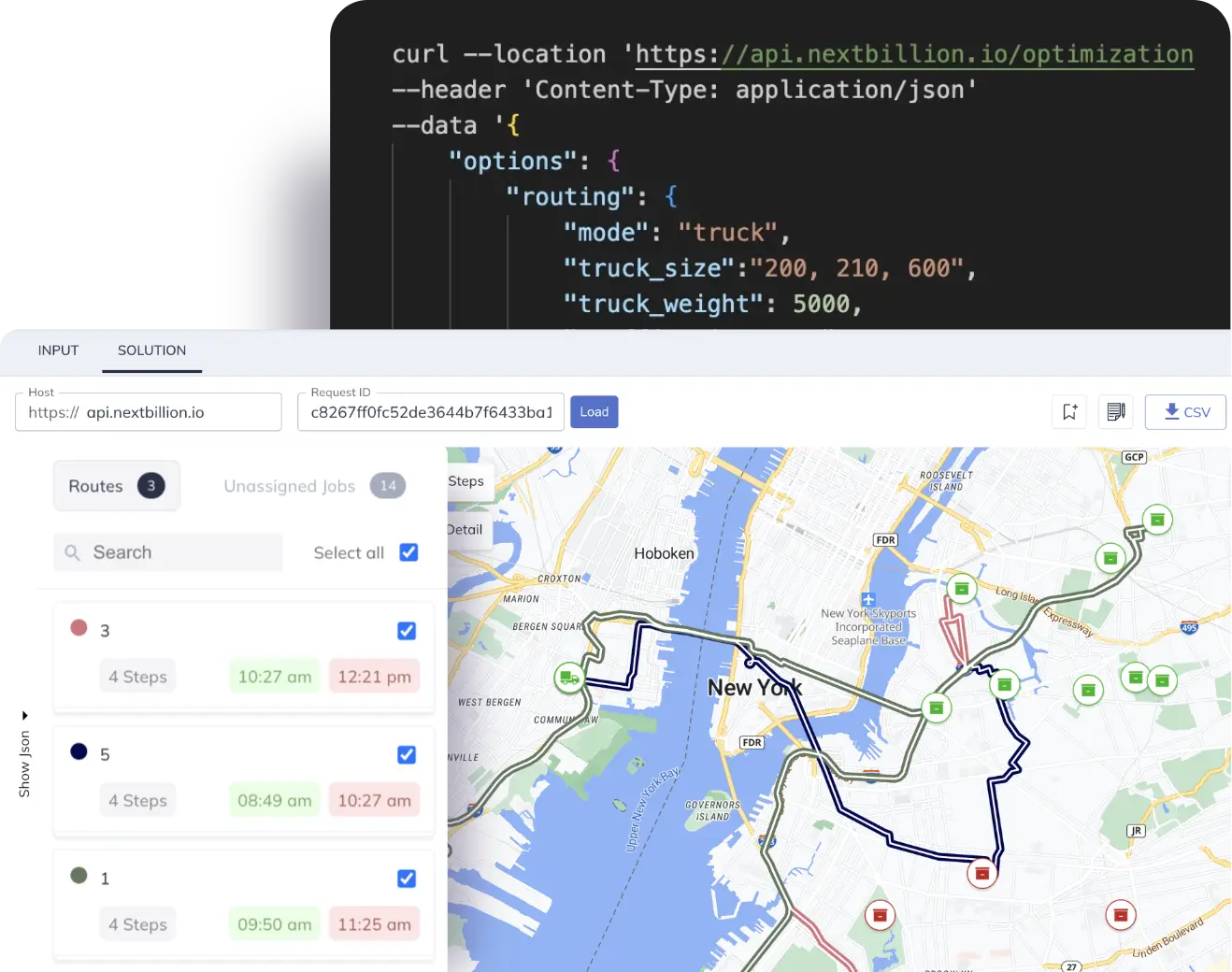
Efficient truck route planning is no longer optional—it’s essential for modern logistics operations. This e-guide serves as a handbook for businesses to get started with truck routing along with actionable insights. From covering the basics of routing to throwing light on important aspects of route planning algorithm, the essential role of route optimization has been highlighted.
We are constantly improving our customer’s routing experience and have been confident to contribute in making their operations seamless and efficient. If you are looking for more in-depth information or need to discuss a certain use-case, feel free to get in touch with us.




